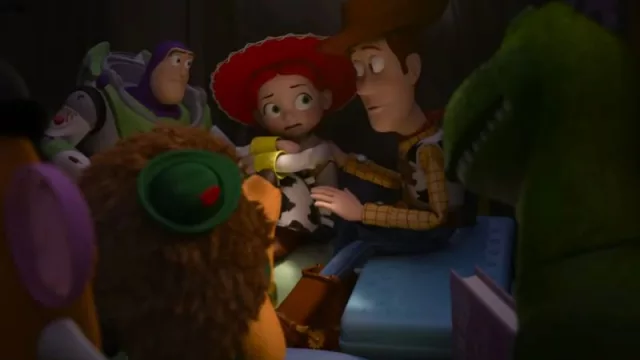-
Not only are children reading very little, but teenagers and adults—including managers and business owners—are also doing so, and this is critically serious in every sense.
-
Urgently, we need awareness and action to reverse (yes, a significant reduction is necessary) the current excessive consumption of videos and apps among children.
It is vital that parents, grandparents, teachers, uncles, and siblings consistently encourage children to read much more, to draw and write by hand, in analog, and to leave dependence on tablets and smartphones. -
Directed (according to official announcements and previews by Pixar) for release in 2026, the film continues the emotional legacy of the saga and sparks a relevant debate for families, schools, and communities across LATAM, Miami, the U.S., and Spain.
From a business perspective, it presents an opportunity for transmedia development and partnerships with publishers, educational platforms, and reading promotion programs.
-
The pursuit of balance between digital and analog is much closer—focused on reducing digital use and promoting manual activities, which should also include digital actions that depend on tactile, manual engagement.
-
If this shift is not dramatically achieved, the damage to our skills—across children, youth, and adults—will exponentially increase.
We recommend reading this assertive report based on Rita Carter’s recommendations.
In today’s world—marked by constant technological evolution and an avalanche of digital information—Rita Carter, a renowned British neuroscientist and science communicator, emerges as a passionate advocate for reading and its powerful benefits.
LilyPad, a children's tablet, stands as the symbolic antagonist in a story exploring how imagination can coexist with technology without losing its essence.
(Synopsis—without detailed spoilers)
-
In an increasingly connected universe, Bonnie’s toys—and the classic characters of the saga—must reinvent their roles in the face of devices promising instant learning, entertainment, and a window into a universe of online content. LilyPad, the main device of this new installment, introduces a conflict between physical play and digital experience.
-
The plot, with Pixar’s characteristic humor and talent for personifying objects, invites reflection on limits, cooperation, and the importance of imagination in forming identity. The characters’ arc maintains a nostalgic tone while offering freshness through group dynamics and new collective goals.
Thematic Analysis
-
Imagination vs. Technology:
Toy Story 5 raises a crucial debate for families and schools: how to harness technology without sacrificing the ability to dream, create worlds, and develop empathy. LilyPad embodies the temptation to depend on digital help; the film suggests that children’s creativity flourishes through direct interaction, symbolic play, and social context. -
Education and Entertainment:
The movie hints at a transmedia model where play merges with learning experiences, fostering discussions about literacy, critical thinking, and responsible digital literacy. -
Identity and Belonging:
Toys build their identity not only through function and use but via shared stories, collective memory, and the possibility of being part of a team. The challenge is maintaining cohesion amidst a dynamic and isolating content ecosystem.
Multicultural and Family Contexts:
The film resonates with multicultural and bilingual audiences, especially in LATAM, Miami, the U.S., and Spain, where family, education, and leisure dynamics intertwine with diverse identities.
-
Its proposal to combine play, memory, and reflection on responsible technology use aligns with contemporary trends in education, family life, and cultural consumption.
-
If Toy Story 5 balances the franchise’s humor with a critical, hopeful perspective on childhood’s future in a digital era, it could become an emotional and educational milestone for global audiences, including LATAM, Miami, the U.S., and Spain.
Characters and Emotional Arc
-
Classic Toys: Maintain their warm humor and leadership spirit but must adapt to a screen-filled environment without losing their core essence.
-
LilyPad: Not just a technological figure; it reflects contemporary questions about digital dependence, autonomy of imagination, and the value of tactile, shared experiences.
-
New Group Dynamics: The cast includes characters learning to collaborate in the face of the temptation of quick digital solutions, emphasizing values like patience, cooperation, and curiosity.
Direction, Pace, and Visual Style
-
Direction and Tone: Pixar continues its formula of blending accessible humor with human drama, maintaining a polished aesthetic and narratives that highlight the humanity behind each animated object. The visual experience aims to be nostalgic yet contemporary.
-
Pace: Balances dynamic action sequences with moments of calm and reflection, offering a family-friendly cinematic experience with layers for more mature viewers.
-
Character and World Design: The color palette and LilyPad’s design contrast with the warm, tactile look of traditional toys, visually reinforcing the central theme of the interaction between the analog and digital worlds.
Music, Sound, and Sensory Experience
-
Soundtrack: Likely to feature motifs that evoke memory and family rituals while incorporating modern nuances to reflect technological presence.
-
Diegetic and Ambient Sound: The mix aims to emphasize the sensory experience of toys—the creak of pieces, button sounds, and resonances of shared stories—highlighting active listening and family engagement.
Cultural Impact and Strategic Potential
-
Relevance for LATAM, Miami, and Spain:
The film addresses a universal theme: how to maintain play and reading quality in a screen-dominated ecosystem. This ties into regional initiatives promoting reading, responsible digital education, and critical use of technology at home and school. -
Transmedia Opportunities:
Toy Story 5 could spawn educational extensions—conversation guides, didactic materials, books, theme park experiences, and interactive streaming content—strengthening Disney/Pixar’s reputation as a family entertainment brand with educational value. -
Commercial Context:
Given the franchise’s success with Toy Story 3 and 4, it has the potential to attract multigenerational audiences and turn the film into a cultural phenomenon, with merchandising, educational alliances, and parallel content.
Notes for Fans and Discussions
-
Reflective questions:
How can families balance digital entertainment with imaginative play at home?
What is the boundary between tech-assisted learning and free exploration on the table or floor?
What messages does the film send to families redefining their relationship with screens? -
Connections to other works:
Toy Story 5 continues Pixar’s tradition of using inanimate objects to explore deep emotions and ethical dilemmas, while also examining the social and cultural impact of technology in everyday life.
This topic lends itself to sharing all related notes and expanding further with additional insights.
Subscribe to Infonegocios.Miami for more analysis where sports, science, and business collide.
Read Smart, Be Smarter!
Infonegocios NETWORK: 4.5 million Anglo-Latinos united by a passion for business.
Join us and stay informed:
Subscribe for free
Contact Infonegocios MIAMI:
-
marcelo.maurizio@gmail.com












Tu opinión enriquece este artículo: